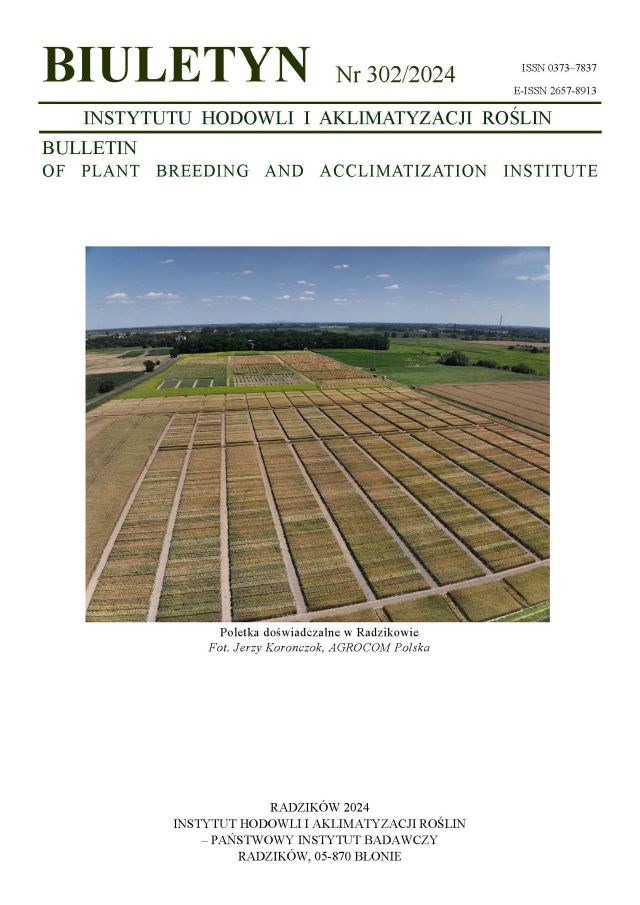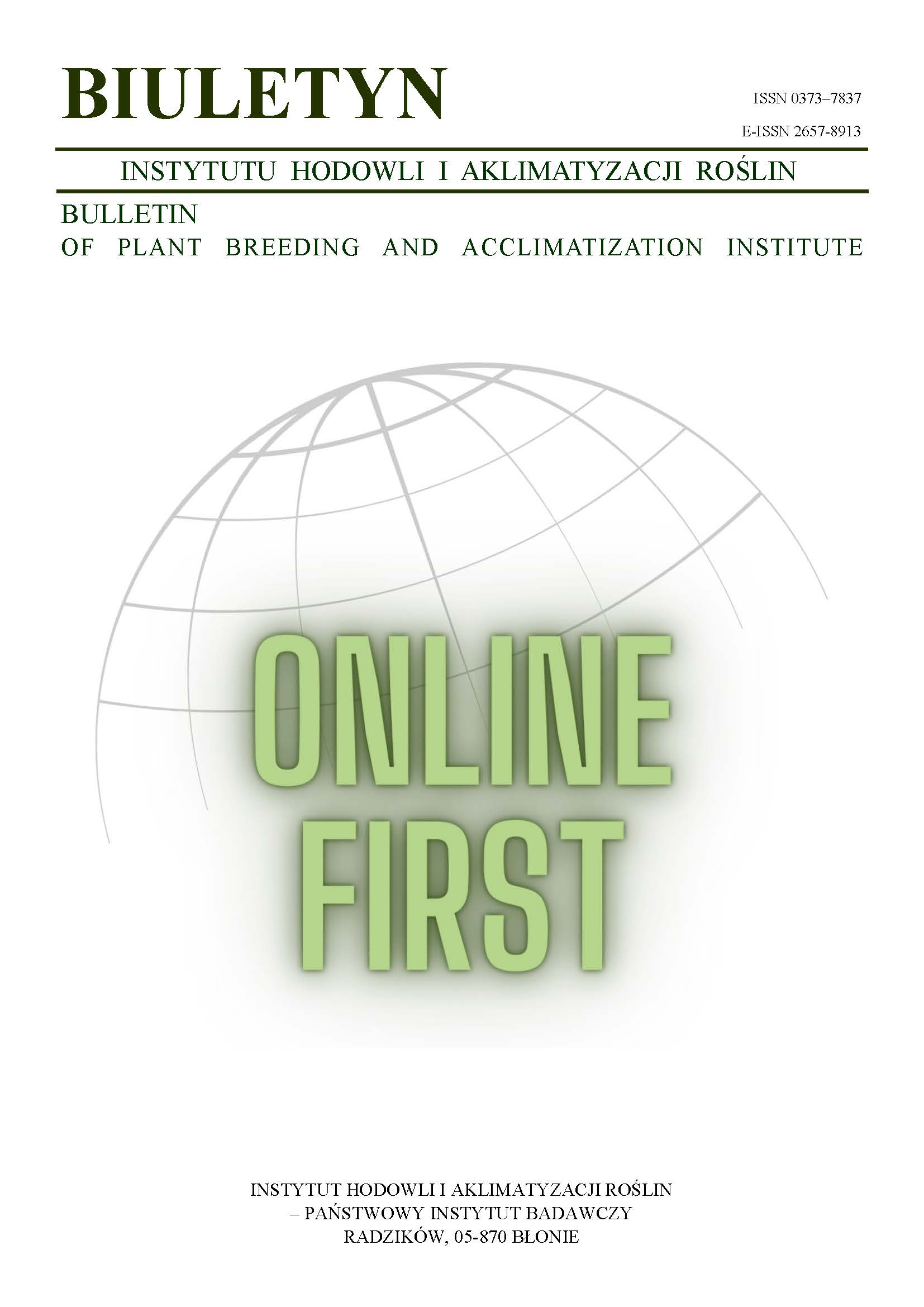Genetic possibilities of grain quality improvement of winter wheat Triticum aestivum L. in the effect of introgressive hybridization with Triticum durum Desf.
Józef Pilch
j.pilch@ihar.edu.plZakład Oceny Jakości i Metod Hodowli Zbóż, Instytut Hodowli i Aklimatyzacji Roślin w Krakowie (Poland)
Abstract
In the paper, the technological grain quality of 64 winter introgressives T. aestivum L./ T. durum Desf. was analyzed. The technological evaluation contained the 4-year results regarding protein content (%), Zeleny-sedimentation indicator (ml), falling number (s), baking value (the classes E, A, B, C) and SDS-PAGE electrophoresis of the high-molecular-weight (HMW) glutenins. The results were compared to those obtained with quality variety Begra of T. aestivum L. The majority of the introgressives exhibited the values of the indicators which were equal (to class A) or exceeded (class E) the variety Begra. The protein content Zeleny-sedimentation indicator, falling number and the baking value of class E were recorded for 46.8, 21.8, 96.8 and 18.6% of the introgressives, respectively The SDS-PAGE electrophoresis of HMW-glutenins showed (1) the presence of homoeological alleles at the loci Glu-A1 and Glu-B1 in 85.9% of the introgressives, (2) the allelic breakages in the locus Glu- D1 with the genesis of new combination of subunits 5+12 in 6.3% and (3) the introgressions of the alien alleles at the loci Glu-1 with the unknown subunits in 7.8% of the introgressives. The results showed that the introgressive hybridization of T. aestivum L. with the tetraploid wheat of the species T. durum Desf. can result in incerasing the grain quality in winter wheat T. aestivum L., arising from the introgressions of A, B genome alleles or from the chromosome-passage effects under the alien chromosome influence.
Keywords:
Triticum aestivum L., Triticum durum Desf., high-molecular-weight glutenins, grain, introgressive hybridization, technological indicatorsReferences
Autran J. C., Galterio G. 1989. Associations between electrophoretic composition of protein, quality characteristics and agronomic attributes of durum wheat. II. Protein quality association. J. Cereal Sci. 9: 195 — 215.
DOI: https://doi.org/10.1016/S0733-5210(89)80002-5
Google Scholar
Anderson O. D., Abraham-Pierce F. A., Tam A. 1998. Conservation in wheat high-molecular-weight glutenin gene promoter sequences: comparisons among loci and among alleles of the Glu-B1-1 locus. Theor. Appl. Genet. 96: 568 — 576.
DOI: https://doi.org/10.1007/s001220050775
Google Scholar
Baulcombe D. C., Huttly A. K., Martienssen R., Barker R. F., Jarvis M. G. 1987. A novel wheat alpha- amylase gene (L-Amy 3). Mol. Gen. Genet. 209: 33 — 34.
DOI: https://doi.org/10.1007/BF00329833
Google Scholar
Blanco A., Bellomo M. P., Lotti C., Pasquolone A. 1998. Mapping of quantitative trait loci for grain quality using recombinant inbred lines of durum wheat. Proc. of the 10th EWAC Meeting, Viterbo — Italy (Ed. C. Ceoloni, Worland A. J.: 106 — 109.
Google Scholar
Branlard G., Autran J. C., Monneveux P. 1989. High molecular weight glutenin subunits in durum wheat (Triticum durum). Theor. Appl. Genet. 78: 353 — 358.
DOI: https://doi.org/10.1007/BF00265296
Google Scholar
Carrillo J. M., Rousset M., Qualset C. O., Kasarda D. D. 1990. Use of recombinant inbred lines of wheat for study of associations of high-molecular weight glutenin subunit alleles to quantitative traits. I. Grain yield and quality prediction tests. Theor. Appl. Genet. 73: 321 — 330.
DOI: https://doi.org/10.1007/BF01186074
Google Scholar
Ciaffi M., Benedeltelli S., Giorgi B., Porceddu E., Lafiandra D. 1992. Seed storage proteins of Triticum turgidum spp. dicoccoides and their effects on technological quality in durum wheat. Plant Breeding 107: 309 — 319.
DOI: https://doi.org/10.1111/j.1439-0523.1991.tb00554.x
Google Scholar
Dessalegn T., Van Deventer C. S., Labuschagne M. T., Maartens H. 2003. B-LMW glutenin and y-gliadin composition of Ethiopian durum wheat genotypes and their association with some quality traits. Cereal Res. Commun. 31, 3–4: 453 — 457.
DOI: https://doi.org/10.1007/BF03543378
Google Scholar
Dexter J. E., Matsuo R. R. 1987. Relationship between durum wheat properties and pasta dough rheology and spaghetti cooking quality. J. Agric. Food. Chem. 26: 899 — 905.
DOI: https://doi.org/10.1021/jf60231a034
Google Scholar
Dong H., Cox T. S., Sears R. G., Lockhard G. L. 1991. High molecular weight glutenin genes: Effects on quality in wheat. Crop.Sci. 31: 971 — 979.
DOI: https://doi.org/10.2135/cropsci1991.0011183X003100040027x
Google Scholar
D’Ovidio R, Simeone M., Masci S., Porceddu E. 1997. Molecular characterization of a LMW-GS gene located on chromosome 1B and the development of primers specific for the Glu-B3 complex locus in durum wheat. Theor. Appl. Genet. 95: 119 — 126.
DOI: https://doi.org/10.1007/s001220050671
Google Scholar
Forde J., Malpica J. M., Halford N. G., Shevry P. R., Anderson O. D., Green F. C. 1985. The Nucleotide sequence of a HMW glutenin subunit gene located on chromosome 1A of wheat (Triticum aestivum L.) Nucleic Acids Res. 13: 6817 — 6832.
DOI: https://doi.org/10.1093/nar/13.19.6817
Google Scholar
Juhasz A., Larroque O. R., Tamas L., Hsam S. L. K., Zeller F. J., Bekes F., Bedo Z. 2003. Bankuti 1201 an old Hungarian wheat variety with special storage protein composition. Theor. Appl. Genet. 107: 697 — 704.
DOI: https://doi.org/10.1007/s00122-003-1292-2
Google Scholar
Kaczyński L. 2002. Pszenica ozima. Lista opisowa odmian 2002. (wyd. E. Gacek, Centralny Ośrodek Badania Odmian Roślin Uprawnych, Słupia Wielka): 20 — 35.
Google Scholar
Kazman E., Lelley T. 1994. Rapid incorporation of D-genome chromosomes into A and/ or B genomes of hexaploid triticale. Plant Breeding 113: 89 — 98.
DOI: https://doi.org/10.1111/j.1439-0523.1994.tb00710.x
Google Scholar
Klockiewicz-Kamińska E., Brzeziński W. J. 1997. Metoda oceny i klasyfikacji jakościowej odmian pszenicy. Wiad. Odm. COBORU 67: 1 — 18.
Google Scholar
Lafferty J., Lelley T. 2001. Introduction of high molecular weight glutenin subunits 5+10 for the improvement of the bread-making quality of hexaploid triticale. Plant Breeding 120 (1): 33 — 37.
DOI: https://doi.org/10.1046/j.1439-0523.2001.00567.x
Google Scholar
Lin C. Y., Shepherd K. W. 1996. Variation of B subunits of glutenin in durum wild and less-widely cultivated tetraploid wheats. Plant Breed. 115: 172 — 178.
DOI: https://doi.org/10.1111/j.1439-0523.1996.tb00896.x
Google Scholar
Lorenzo A., Kronstad W. E., Vieira L. C. E. 1987. Relationship between high molecular weight glutenin subunits and loaf volume in wheat as measured by the sodium dodecyl sulfate sedimentation test. Crop. Sci. 27: 253 — 257.
DOI: https://doi.org/10.2135/cropsci1987.0011183X002700020026x
Google Scholar
Lukaszewski A. J., Brzezinski W., Klockiewicz-Kaminska E. 2000. Transfer of the Glu-D1 locus encoding high molecular weight glutenin subunits 5+10 from bread wheat to diploid rye. Euphytica 115: 49 — 57.
DOI: https://doi.org/10.1023/A:1004085528286
Google Scholar
Lukaszewski A. J., Curtis C. A. 1992. Transfer of the Glu-D1 gene from chromosome 1D of bread wheat to chromosome 1R in hexaploid triticale. Plant Breeding 109: 203 — 210
DOI: https://doi.org/10.1111/j.1439-0523.1992.tb00174.x
Google Scholar
Lukaszewski A. J., Curtis C. A. 1994. Transfer of the Glu-D1 gene from chromosome 1D to chromosome 1A in hexaploid triticale. Plant Breeding 112: 177 — 182.
DOI: https://doi.org/10.1111/j.1439-0523.1994.tb00668.x
Google Scholar
Mac Gregor E. A., Mac Gregor A. W. 1987. Studies of cereal L-amylases using cloned DNSA. Rev. Biotech. 5: 129 — 142.
DOI: https://doi.org/10.3109/07388558709086973
Google Scholar
Odenbach W., Mahgoub E. S. 1988. Relationships between HMW glutenin subunit composition and the sedimentation value in reciprocal sets of inbred backcross lines derived from two winter wheat crosses. Proc. 7 th Int.Wheat Genet. Symp., Cambridge (England): 987 — 991.
Google Scholar
Payne P. I., Lawrence G. J. 1983. Catalogue of alleles for the complex gene loci Glu-A1, Glu-B1, Glu-D1 which code for high-molecular-weight subunits of glutenin in hexaploid wheat. Cer. Res. Commun. 11: 29 — 36.
Google Scholar
Pilch J. 1987. Substytucje i delecje heterochromatynowe chromosomów żyta (Secale cereale L.) oraz ich związek z niektórymi cechami użytkowymi pszenżyta heksaploidalnego. Hod. Rośl. Aklim. 30, 3/4: 1 — 52.
Google Scholar
Pilch J. 1996. Performance of interspecific and intergeneric hybrids of Triticum aestivum L. for wheat improvements. Part I. Performance of winter generations F3–F5 of T. aestivum L. with Triticum {2x, 4x}, Aegilops {2x}, and Elymus {4x} species in respect of some characters of spike. Plant Breed. and Seed Sci. vol. 40, no. 3-4: 73 — 62.
Google Scholar
Pilch J., Głowacz E., Cygankiewicz A. 1999. Wartość wypiekowa ziarna mieszańców pszenicy pochodzących z krzyżowań międzygatunkowych i międzyrodzajowych. Biul. IHAR 210: 71 — 83.
Google Scholar
Pilch J. 2002. Transformacje cech kłosa pszenicy Triticum aestivum L. z wykorzystaniem międzygatunkowej i międzyrodzajowej hybrydyzacji. Zeszyty Problemowe Postępów Nauk Rolniczych z. 488: 207 — 213.
Google Scholar
Rogers W. J., Miller T. E., Payne P. I., Seekings J. A., Sayers E. J., Holt L. M., Law C. N. 1997. Introduction to bread wheat (Triticum aestivum L.) and assessment for bread-making quality of alleles from T. boeoticum Boiss. ssp. thoudar at Glu-A1 encoding two high-molecular-weight subunits of glutenin. Euphytica 93: 19 — 29.
DOI: https://doi.org/10.1023/A:1002991206350
Google Scholar
Sabelli P. A., Shevry P. R. 1991.Characterization and organization of gene families at the Gli-1 loci of bread and durum wheat’s by restriction fragment analysis. Theor. Appl. Genet. 83: 209 — 216.
DOI: https://doi.org/10.1007/BF00226253
Google Scholar
Schepers J., Keizer L. C. P., Kolster P. 1993. The relation between high molecular weight glutenin subunits, bread-making quality and agronomic properties of winter wheat. Cereal Res. Commun. 21, no.4: 289 — 296.
Google Scholar
Szwed-Urbaś K., Segit Z., Mazurek H. 1997. Parametry jakościowe ziarna krajowych linii pszenicy twardej (Triticum durum Desf.). Biul. IHAR 204: 129 — 140.
Google Scholar
Turchetta T., Ciaffi M., Porceddu E., Lafiandra D. 1995. Relationship between electrophoretic pattern of storage proteins and gluten strength in durum wheat landraces from Turkey. Plant Breeding 114: 406 — 412.
DOI: https://doi.org/10.1111/j.1439-0523.1995.tb00821.x
Google Scholar
Vitellozzi F. Ciaffi M., Dominici L., Ceoloni C. 1997. Isolation of a chromosomally engineered durum wheat line carrying the common wheat Glu-D1d allele. Agronomie 17: 413 — 419.
DOI: https://doi.org/10.1051/agro:19970805
Google Scholar
Zillman R.R., Bushuk W. 1979. Wheat cultivar identification by gliadin electrophoregrams. III. Can. J. Plant Sci. 59: 287.
DOI: https://doi.org/10.4141/cjps79-048
Google Scholar
Authors
Józef Pilchj.pilch@ihar.edu.pl
Zakład Oceny Jakości i Metod Hodowli Zbóż, Instytut Hodowli i Aklimatyzacji Roślin w Krakowie Poland
Statistics
Abstract views: 72PDF downloads: 30
License
Copyright (c) 2005 Józef Pilch

This work is licensed under a Creative Commons Attribution-ShareAlike 4.0 International License.
Upon submitting the article, the Authors grant the Publisher a non-exclusive and free license to use the article for an indefinite period of time throughout the world in the following fields of use:
- Production and reproduction of copies of the article using a specific technique, including printing and digital technology.
- Placing on the market, lending or renting the original or copies of the article.
- Public performance, exhibition, display, reproduction, broadcasting and re-broadcasting, as well as making the article publicly available in such a way that everyone can access it at a place and time of their choice.
- Including the article in a collective work.
- Uploading an article in electronic form to electronic platforms or otherwise introducing an article in electronic form to the Internet or other network.
- Dissemination of the article in electronic form on the Internet or other network, in collective work as well as independently.
- Making the article available in an electronic version in such a way that everyone can access it at a place and time of their choice, in particular via the Internet.
Authors by sending a request for publication:
- They consent to the publication of the article in the journal,
- They agree to give the publication a DOI (Digital Object Identifier),
- They undertake to comply with the publishing house's code of ethics in accordance with the guidelines of the Committee on Publication Ethics (COPE), (http://ihar.edu.pl/biblioteka_i_wydawnictwa.php),
- They consent to the articles being made available in electronic form under the CC BY-SA 4.0 license, in open access,
- They agree to send article metadata to commercial and non-commercial journal indexing databases.
Most read articles by the same author(s)
- Józef Pilch, Effectiveness of HMW — glutenin gene Glu-1 introgressions in bread-making quality improvement of cereals — a review , Bulletin of Plant Breeding and Acclimatization Institute: No. 243 (2007): Regular issue
- Józef Pilch, Introgressions of genes from taxonomically related species in improvement of wheat Triticum aestivum L. and other cultivated plants , Bulletin of Plant Breeding and Acclimatization Institute: No. 260/261 (2011): Regular issue
- Józef Pilch, Using genes of diploid, tetraploid and hexaploid species of wheat Triticum L. in the varieties of hexaploid wheat Triticum aestivum L. , Bulletin of Plant Breeding and Acclimatization Institute: No. 262 (2011): Regular issue
- Józef Pilch, Possibilities of using of introgressive hybridization in breeding of winter wheat T. aestivum L. , Bulletin of Plant Breeding and Acclimatization Institute: No. 235 (2005): Regular issue
- Józef Pilch, Effect of the A and B genomes Triticum durum Desf. on bread-making quality in winter wheat Triticum aestivum L. , Bulletin of Plant Breeding and Acclimatization Institute: No. 230 (2003): Regular issue
- Józef Pilch, Genetic determination of the morphological traits of a spike of wheat (Triticum aestivum L.) , Bulletin of Plant Breeding and Acclimatization Institute: No. 228 (2003): Regular issue
- Józef Pilch, Possibilities of using of introgressive hybridization in breeding of winter wheat T. aestivum L. , Bulletin of Plant Breeding and Acclimatization Institute: No. 235 (2005): Regular issue














